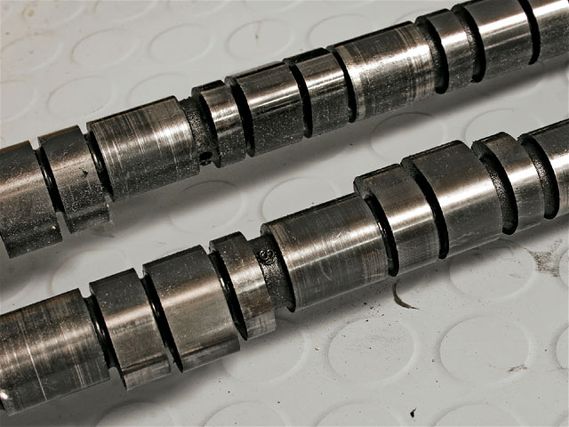 | Honda Engine Swap and B16 Cam Questions Answered - August 2008 Exhaust Notes
| Honda Engine Swap and B16 Cam Questions Answered - August 2008 Exhaust Notes
I have a question related to the camshafts on a B16A engine. Some of the lobes on those camshafts don't appear to serve a useful purpose. Am I wrong? If I am wrong, what purpose do those lobes serve?
- Bill Johnson
San Luis Obispo, Calif.
Come on, do you really think Honda would stick something in that head if it didn't need to be there? Those extra lobes do the same thing that any other camshaft lobes do-make valves go up and down with rocker arms-they just don't do it all the time.
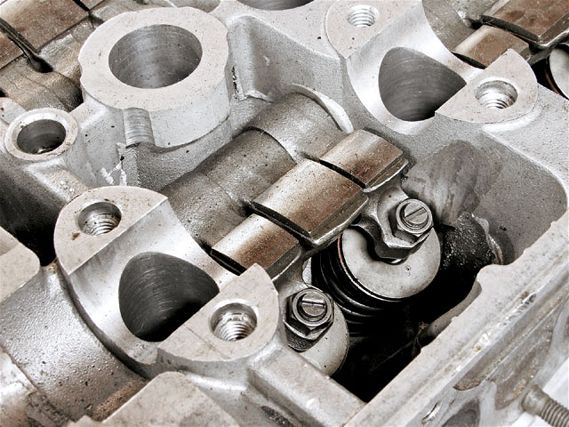 | Honda Engine Swap and B16 Cam Questions Answered - August 2008 Exhaust Notes
| Honda Engine Swap and B16 Cam Questions Answered - August 2008 Exhaust Notes
You have heard of VTEC, right? VTEC is just Honda's fancy way of saying an engine's got variable valve timing and essentially means a single camshaft has two lift and duration profiles. Under low-rpm conditions, the two outside lobes move the two intake or exhaust valves up and down (depending on which cam you're talking about), but once the VTEC solenoid is triggered, all three lobes lock into place by means of an oil pressure driven pin. At this point, the center lobe and rocker arm are doing all the work, transferring motion onto the other two rocker arms we just mentioned. Once VTEC is engaged, the outer camshaft lobes aren't doing anything. VTEC triggers at a specified engine speed-depending upon the ECU used-that is based on a number of factors, including oil pressure and coolant temperature. The results give you the best of both worlds-a high-lift, long-duration cam profile typically unheard of on production-based vehicles without variable valve timing, and an emissions-friendly, fuel-conscious, cam profile for low-rpm driving, with a relatively clean burn.
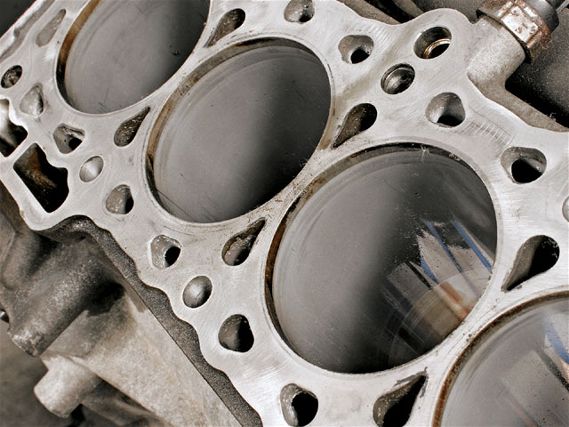 | Honda Engine Swap and B16 Cam Questions Answered - August 2008 Exhaust Notes
| Honda Engine Swap and B16 Cam Questions Answered - August 2008 Exhaust Notes
I get your magazine every month and in the Exhaust Notes section of the May '08 issue you were talking about the H22A. You were saying that its cylinder walls are fiber-reinforced metal (FRM). What exactly does that mean? I have wanted to put an H22A into a CRX or Del Sol for some time. Are there advantages or disadvantages to FRM?
- David Jones
Houston, Tex.
With the exception of a few oddballs, including the H22A, most Honda engines use cast-iron cylinder liners. Unlike cast iron, FRM is a metal-matrix composite made from carbon fiber and aluminum oxide, both high-end materials. The benefits of FRM as opposed to cast iron include improved heat transferring from the cylinders to the water jackets, higher wear resistance, and less weight. FRM allows designers to keep engine package and cooling system sizes minimal since heat-transfer properties are better, but Honda didn't exactly do that with the H22A. Instead of making the block smaller, which would in turn decrease the cooling system's jackets and port dimensions, Honda kept it the same, which means FRM-lined H22As are potentially more efficient in terms of cooling than cast-iron-lined engines, which means, in theory, they'll last longer. FRM is ceramic based, like spark plug insulators, so it's more durable than cast iron and theoretically has a longer service life. Theoretically. There's nothing wrong with FRM liners, that is, until you get into a buildup, and even then they're not so bad. The problem lies not just with the liners but the pistons. Honda developed special gravity-cast, aluminum-alloy pistons with specific expansion rates that work in an FRM environment. FRM liners expand more than cast-iron ones, which means the pistons have got to account for the expansion. Most aftermarket forged pistons are manufactured for use with cast-iron liners, which means popping a set in an FRM block can spell serious problems. None of this is really that big of a deal anymore though. A few piston manufacturers offer FRM-compatible forged pistons and ring sets and, if that doesn't float your boat, you can always sleeve the block with ductile iron sleeves, which you'd end up needing anyway if you're shooting for big numbers.
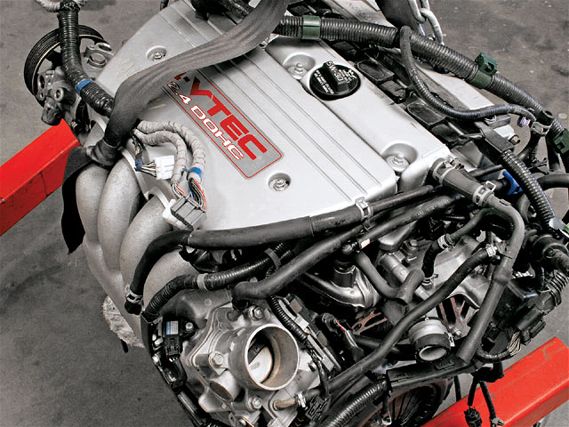 | Honda Engine Swap and B16 Cam Questions Answered - August 2008 Exhaust Notes
| Honda Engine Swap and B16 Cam Questions Answered - August 2008 Exhaust Notes
I have a '97 Civic EX, which of course you know has the almighty D16Y8 engine. I have the typical bolt-on parts-Tanabe SMR exhaust system, DC Sport headers, and an AEM cold-air intake. The engine has about 136,000 miles on it and I'm trying to figure out what my next step is. I have two options. I would like to turbo the D16 and get at least 200 hp out of it but will I have to rebuild the engine because of the miles? Also, what would be a good turbo kit since it will still be a daily driven car? Could I take it to a performance shop and get a custom turbo? Option two: When I first got the car in 2005 I had my mind set on dropping in a GSR engine and then later on turbocharging it, but then I got interested in the K-series engines. My Mom got a TSX, and I love driving the car, so I really got hooked on the K. What do you recommend? Thanks for any advice. Eat, sleep, Honda.
- Phil Dillon
Jacksonville, Fla.
This is really going to boil down to personal preference. All three options will land you in the 200-plus horsepower zone, just in different ways. Turbocharging your D-series will cost you the least, until you start breaking things. Once those ring lands fail or a connecting rod snaps you're looking at another engine or a rebuild, neither of which will be all that cheap. Do compression and leakdown tests on your single cam before considering a turbo kit. If compression is significantly low or uneven or leakdown results are high, your decision just got easier. Both GSR and K-series swaps have their benefits: B18C swaps are simple in your chassis. If you've got the right amount of fingers and brain cells, you can get one done in an afternoon. K swaps are a bit more complicated, not to mention expensive, but are no doubt more powerful than any stock B18C. It sounds like you need to consider what is most important to you. Do you care about emissions? What about cost? Are you afraid of a potential rebuild down the road? But you asked us for our opinion. Do the K swap. It'll get you past that 200hp mark right out of the box, which means you won't even have to mess with turbochargers, rebuilds, or Honda's infamous reliability.
I have a first-generation B16A in my '90 Si hatchback and I have noticed that the B16A's torque sucks compared to the B20 or the LS engines. I was wondering if there was a way to get more torque out of my engine without using forced-induction or expensive stroker kits, or should I say screw it all and do the notorious B20-VTEC setup?
- Chadwick King
Limestone, Tenn.
You'll probably need to screw it all and go B20-VTEC. The B16A's peak torque output doesn't necessarily suck but its overall torque curve isn't the greatest. There are two easy ways to significantly improve low-end and midrange torque-through increased displacement or forced-induction. You've already said you aren't interested in turbocharging your B16A and, if torque is that important to you, we'd suggest stroking an inexpensive B18A1 block if you were going to shell out for an expensive stroker kit. The B18A1's taller deck height will get you even more cubic inches than stroking the B16A. But you aren't interested in expensive stroker kits. This brings us to the B20-VTEC setup. This is probably going to be your best option. Hang onto your B16A cylinder head, ECU, and transmission and find yourself a clean B20A block to swap into place. It's instant stroker magic on the cheap. For around $400 you can get yourself a 3mm larger bore and about 12mm of added stroke. The B20A won't be as high-rpm friendly as your B16A, what with its lower rod ratio and all, but it'll provide what you want in ways the B16A never could-generous heaps of torque.
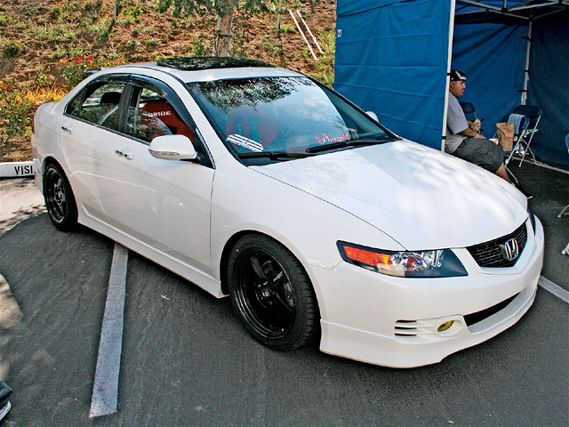 | Honda Engine Swap and B16 Cam Questions Answered - August 2008 Exhaust Notes
| Honda Engine Swap and B16 Cam Questions Answered - August 2008 Exhaust Notes
I was wondering when you guys are going to show more articles on the TSX?
- Robert
Las Vegas, Nev.
Soon. We've already got a few sick TSX features lined up for later this year and have just added a '07 TSX to Honda Tuning's project car fleet. We're staring at a stack of TSX parts as we speak that will be added to the '07 very soon. Stay tuned.
Hi, I'm sort of new to the Honda world and was wondering, is it possible to do an all-wheel-drive setup in a fourth-generation Civic? I've heard about people swapping parts from the all-wheel-drive Civic wagon. Could you please tell me what all is involved and possibly put an article about it in the magazine? Thanks so much for a wonderful magazine and all the hard work you do.
- Jesse
Madison, Wis.
The concept sounds nice, an all-wheel-drive Civic, but it's not as clear-cut as you might think. The first problem has to do with the type of all-wheel-drive system Honda used on the Civic. It isn't anything close to what Subaru uses in its WRX, or Mitsubishi its Evo-those are the cars you've gotten your all-wheel-drive fantasies from, aren't they? Don't feel bad, a lot of people have been scratching their heads trying to figure out ways to make all four of their Civic's wheels do work but, the truth is, most D-, B-, and K-series front-wheel-drive transmissions are stronger than the all-wheel-drive Civic drivetrain you're considering. These rear differentials and axles are weak so if you plan on doing this you may want to research stronger ones. The drivetrain doesn't work how you think it does either. Think of the transmission and rear differential working more or less like a limited-slip differential does-the rear differential only works when the front loses traction, which is different than, say, an all-wheel-drive Eclipse or Evo. With that said, the job isn't all that easy either but it's not impossible. You're going to need an all-wheel-drive wagon to rob the gas tank and rear crossmember from, not to mention the drivetrain pieces and a bunch of other stuff we're probably forgetting. You'll probably need to relocate your spare tire, the exhaust will need to be redirected, and you'll need a custom driveshaft made too. You'll also need to get real comfortable with your MIG-welder or make friends with somebody who is. This is a cool swap, if you have a lot of time on your hands and you're good with tools. Just don't kid yourself into thinking it's Honda's equivalent to Subaru's STI, because it's not.
Got questions, comments, love, or hate?
Send your letters to:
[email protected]
Or snail mail to:
2400 E. Katella Avenue, Suite 1100
Anaheim, CA 92806
